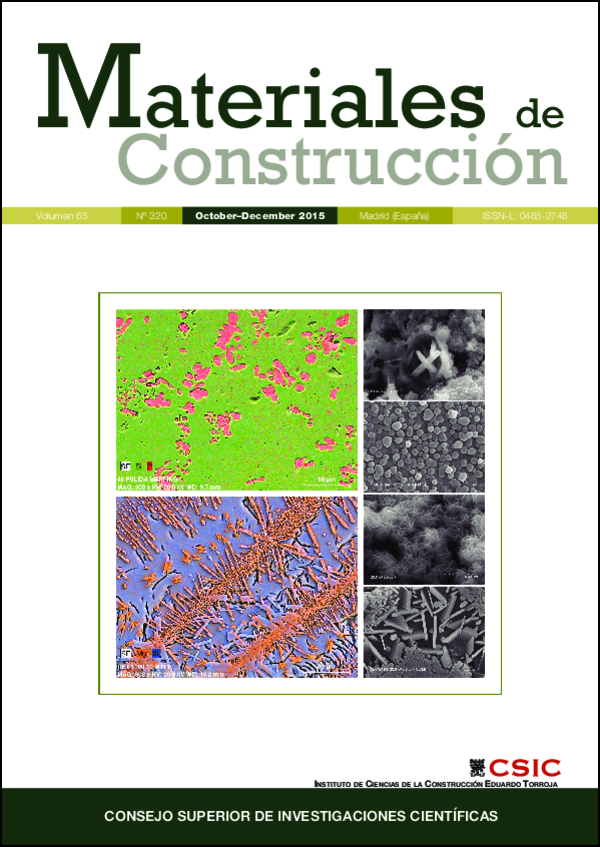Calorimetric study of the early stages of the nanosilica - tricalcium silicate hydration. Effect of temperature
DOI:
https://doi.org/10.3989/mc.2015.06814Keywords:
Calorimetry, Tricalcium silicate, Hydration, Temperature, NanosilicaAbstract
The pozzolanic reaction of nanosilica in contact with C3S was monitored via isothermal conduction calorimetry. Since that reaction is affected by heat, its variations with curing temperature (25, 40 and 65 °C) were also analysed. The findings showed that while C3S hydration was accelerated by both nSA and higher curing temperature, the former impacted the reaction more intensely. Moreover, the presence of nSA was observed to shorten the acceleration stage during C3S hydration, inducing earlier precipitation of portlandite and earlier C-S-H precipitation and nucleation.
Downloads
References
1. Lin, L-K.; Wu, W-S.; Lee, H. (2013). Value analysis and properties investigation of high performance rice husk ash concrete. Adv. Mat. Res. http://dx.doi.org/10.4028/www.scientific.net/amr.773.293
2. Fairbairn, E.M.R.; Americano, B.B.; Cordeiro, G.C.; Paula, T.P.; Toledo Filho, R.D.; Silvoso, M.M. (2010). Cement replacement by sugar cane bagasse ash: CO2 emissions reduction and potential for carbon credits. J. Environ. Manag. 91, 1864–1871. http://dx.doi.org/10.1016/j.jenvman.2010.04.008
3. Thomas, J.J.; Jennings, H.M.; Chen, J.J. (2009) Influence of Nucleation Seeding on the Hydration Mechanisms of Tricalcium Silicate and Cement. J. Phys. Chem. C 113, 4327–4334.
4. Sáez del Bosque, I.F.; Martín-Pastor, M.; Martínez-Ramírez, S.; Blanco-Varela, M.T. (2013) Effect of temperature on C3S and C3S+ nanosilica hydration and C-S-H gel structure. J. Am. Ceram. Soc. 96, 957–965.
5. Kontoleontos, F.; Tsakiridis, P.E.; Marinos, A.; Kaoidas, V.; Katsioti, M. (2012) Influence of colloidal nanosilica on ultrafine cement hydration: Physicolchemical and microstructural characterization. Constr. Build. Mater. 35, 347–360.
6. Ozyildirim, C.; Zegetosky, C. (2010) Exploratory investigation of nanomaterials to improve strength and permeability of concrete. Transport. Res. 2142, 1–2148.
7. Land, G.; Stephan, D. (2012) The influence of nano-silica on the hydration of ordinary Portland cement. J. Mater. Scienc. 47, 1011–1017.
8. Tashima, M.M.; Soriano, L.; Monzó, J.; Borrachero, M.V.; Akasaki, J.L.; Payá, J. (2014) New method to assess the pozzolanic reactivity of mineral admixtures by means of pH and electrical conductivity measurements in lime:pozzolan suspensions. Mater. Construcc. 64, e032.
9. Wadsö, L. (2010) Operational issues in isothermal calorimetry. Cem. Concr. Res. 40, 1129–1137.
10. Quennoz, A. (2011) Hydration of C3A with Calcium Sulfate Alone and in the Presence of Calcium Silicate. Thesis doctoral. EPFL.
11. Barnes, P. (1983). Structure and Performance of Cement. Applied Science Publishers, London, UK.
12. Taylor, H.F.W. (1997) Cement Chemistry. Academia Press, London, U.K.
13. Makar, J.M.; Chan, G.W. (2008) End of the induction period in ordinary portland cement as examined by high-resolution scanning electron microscopy. J. Am. Ceram. Soc. 91, 1292–1299.
14. Juilland, P.; Gallucci, E.; Flatt, R.; Scrivener, K. (2010) Dissolution theory applied to the induction period in alite hydration. Cem. Concr. Res. 40, 831–844.
15. Sato, M.; Diallo, F. (2010) Seeding Effect of Nano-CaCO3 on the hydration of Tricalcium Silicate. Transportation Research Record 2141, 61–67. http://dx.doi.org/10.3141/2141-11
16. Noor-ul-Amin; Alam, S.; Gaul, S.; Muhammad, K. (2013) Hydration mechanism of tricalcium silicate (alite). Adv. Cem. Res. 25, 60–68.
17. Bullard, J.W.; Jennings, H.M.; Livingston, R.A.; Nonat, A.; Scherer, G.W.; Schweitzer, J.S.; Scrivener, K.L.; Thomash, J.J. (2011) Mechanisms of cement hydration. Cem. Concr. Res. 41, 1208–1223.
18. Thomas, J.J.; Biernacki, J.J.; Bullard, J.W.; Bishnoi, S.; Dolado, J.S.; Scherer, G.W.; Luttge, A. (2011) Modeling and simulation of cement hydration kinetics and microstructure development. Cem. Concr. Res. 41, 1257–1278.
19. Thomas, J.J. (2007) A New Approach to Modeling the Nucleation and Growth Kinetics of Tricalcium Silicate Hydration. J. Am. Ceram. Soc. 90, 3282–3288. http://dx.doi.org/10.1111/j.1551-2916.2007.01858.x. http://dx.doi.org/10.1111/j.1551-2916.2007.01858.x
20. Bishnoi, S.; Scrivener, K.L. (2009) μic: A new platform for modelling the hydration of cements. Cem. Concr. Res. 39, 266–274.
21. Zakoutsky´, J.; Tydlitát, V.; Cerny, R. (2012) Effect of temperature on the early-stage hydration characteristics of Portland cement: A large-volume calorimetric study. Constr. Build. Mater. 36, 969–976. http://dx.doi.org/10.1016/j.conbuildmat.2012.06.025
22. Sáez del Bosque, I.F.; Martínez-Ramírez, S.; Blanco-Varela, M.T. (2012) From 30 May to 1 June. Influencia de la relación agua/sólido en la hidratación del silicato tricálcico y de dos cementos portland comerciales (Influence of the water/solid ratio on C3S hydration and two portland cement). In XII Congreso Nacional de Materiales - IBEROMAT XII. Alicante, Spain.
23. Hewlett, P.C. (1988). Lea's Chemistry of Cement and Concrete. Elsevier, Oxford, U.K.
24. Nazari, A.; Riahi, S. (2011) The effects of Cr2O3 nanoparticles on strength assessments and water permeability of concrete in different curing media. Mater. Sci. Eng. A 528, 1173–1182.
25. Alizadeh, R.; Raki, L.; Makar, J.M.; Beaudoin, J.J.; Moudrakovski, I. (2009) Hydration of tricalcium silicate in the presence of synthetic calcium-silicate-hydrate. J. Mater. Chem. 19, 7937–7946.
26. Yu, P.; Kirkpatrick, R.J.; Poe, B.; McMillan, P.F.; Cong, X. (1999) Structure of calcium silicate hydrate (C-S-H): Near-, Mid-, and Far-Infrared Spectroscopy. J. Am. Ceram. Soc. 82, 742–748. http://dx.doi.org/10.1111/j.1151-2916.1999.tb01826.x
Published
How to Cite
Issue
Section
License
Copyright (c) 2015 Consejo Superior de Investigaciones Científicas (CSIC)

This work is licensed under a Creative Commons Attribution 4.0 International License.
© CSIC. Manuscripts published in both the print and online versions of this journal are the property of the Consejo Superior de Investigaciones Científicas, and quoting this source is a requirement for any partial or full reproduction.
All contents of this electronic edition, except where otherwise noted, are distributed under a Creative Commons Attribution 4.0 International (CC BY 4.0) licence. You may read the basic information and the legal text of the licence. The indication of the CC BY 4.0 licence must be expressly stated in this way when necessary.
Self-archiving in repositories, personal webpages or similar, of any version other than the final version of the work produced by the publisher, is not allowed.
















